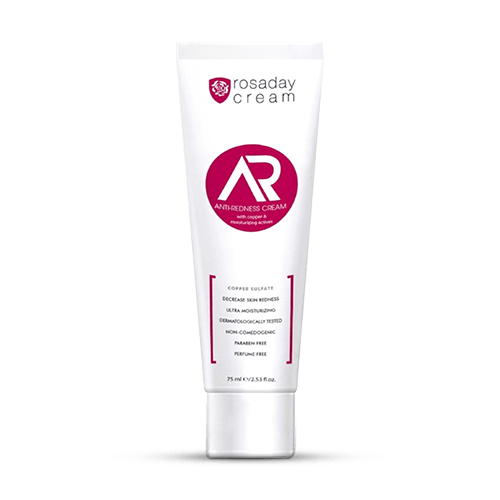Home » Products » Dermocosmetics » Rosaday Cream

Endothelyol, Sopholiance S, Unimoist U-125, Copper Sulphate**
Sebum control and moisturizing effect in the treatment of skin eruptions and reduction of rosacea formation.
Antioxidant, anti-inflammatory, antibacterial, anti-redness, anti-acne and pore-reducing effects,
Endothelyol, Sopholiance S, Unimoist U-125, Copper Sulphate**
Sebum control and moisturizing effect in the treatment of skin eruptions and reduction of rosacea formation.
Antioxidant, anti-inflammatory, antibacterial, anti-redness, anti-acne and pore-reducing effects,
Rosaday Cream moisturizes, soothes the skin and helps reduce redness due to irritation (irritation).
While the Endothelyol™ it contains regulates all the important factors that cause skin redness, it helps to regulate oil production thanks to Sopholiance® S.
After cleansing your skin, apply twice a day (morning and evening) with circular massage movements.
Can be used under makeup.
It is a skin disease that affects the middle part of the face such as the nose, chin, forehead and cheeks, starts with flushing and burning attacks, and then causes permanent redness, increase in capillaries, skin edema and tissue growths. It is also called adult acne or acne rosacea because its clinical features are very similar to acne, but unlike acne seen in young people, it is not caused by the activity of the sebaceous glands.
The exact cause of rosacea is not known. Among the accused reasons;
Rosacea is mostly seen in adults between the ages of 30 and 60 with fair skin and colored eyes. Although it is more common in women, it is more severe in men. Rosacea is a slowly progressive disease and usually occurs in periods (flares).
There are four clinical periods;
1st period: Recurrent episodes of burning and redness on the face,
2nd period: Persistent flushing in the middle of the face and visible small blood vessels on the nose and cheeks,
3rd period: The redness of the face becomes darker and permanent, and small, red bumps or pimples (unlike white or black spots) occur on the nose, cheeks, forehead and chin,
4th period: Burning or persistent tenderness in the eyes (rosacea in the eye) and a red, swollen nose (rhinophyma).
Diagnosis is mostly made according to clinical findings and biopsy is not often required. There is no laboratory finding specific to the diagnosis of rosacea.
Although rosacea can be difficult to cure completely, it is possible to keep it under control with treatment. Treatment is usually determined according to the characteristics of the existing symptoms.
There are no special dietary recommendations other than avoiding the trigger foods listed above. You should also avoid cigarettes and other tobacco products.